Quote:
Originally Posted by ethereal_reality

I remember seeing the unique rifle & pistol sign, but not from this angle.
The St. Charles Hotel between Temple and Aliso St.
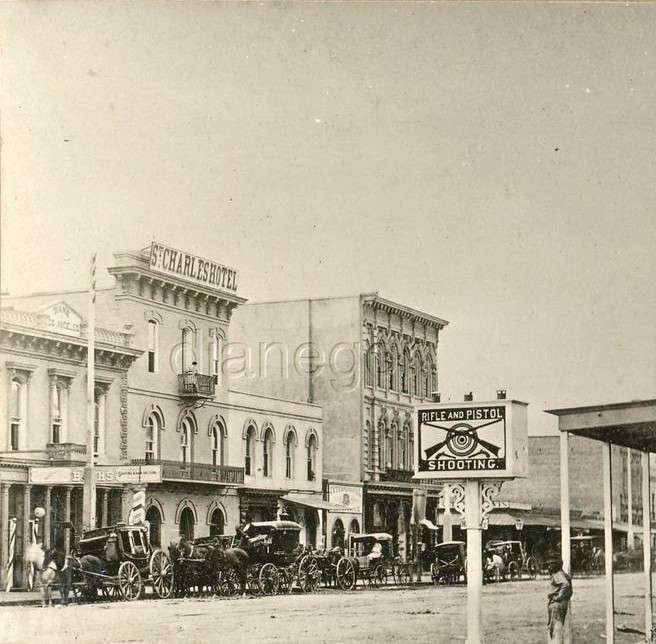
ebay/date unknown
This rifle & pistol shooting sign has always intrigued me. What are the three 'vents' on top, and why is the sign so THICK?
Did it light up? (using gas perhaps) It's just really odd. It reminds me of an arcade sign at a carnival.
__ |
Quote:
Originally Posted by BifRayRock

Is it real? An experiment with mixed results?
Your earlier post approximated the date as 1876. Are there other images that include the sign from another vantage point?
The sign seems an historical anomaly, or maybe something other than we suspect, which may have been the primary reason for the attention-grabbing photo. Its very subject presents itself as great target for mischief. Compared with the presumably normal-sized human standing near the sign, the sign looks quite big. This might explain its width and the fancy (presumed) cast iron supports. What tends to look like vents support the conclusion of back lighting. Yet a big backlit sign would have required many lumens to be effective, so maybe given the weird scale of the sign, those are "smoke stacks" - rather than vents. A big sign might have been easier to illuminate via exterior reflected light.
Unless the maker had invented plexiglass or transparent aluminum, a backlit sign was likely mica or glass, and therefore fragile. Stones and other small objects were a known hazard to glass (and even mica) in the late 19th Century. Flying objects were known to occur when stage coaches needed to keep on schedule (verified by watching Hopalong Cassidy and Gunsmoke) and when normal school was in recess.
Did the sign advertise a shooting range that some distance away? When there was probably quite a bit of nearby unimproved land, for use as a make-shift range, was there really much demand for an in-town shooting range? (Unless it also served drinks, food and ammo.) A "legalized" in-town range would have been a nuisance to nearby humans and livestock. ("Come stay in the St. Charles Hotel! Conveniently located near a modern, state of the art, super-quiet, rifle range?")
|
Oh, there was a real shooting gallery there all right:

1879 LA City Directory @ Fold3.com
April 7, 1878 LA Herald:

Library of Congress --
http://chroniclingamerica.loc.gov/lc...arRange&page=1
October 4, 1878 LA Herald:

Library of Congress --
http://chroniclingamerica.loc.gov/lc...arRange&page=5
As to exactly
when the shooting gallery was there . . . here's a c. 1874 photo looking south on Main from the Pico House. The "Y" pattern in the dirt of Main Street opposite the two livery stables is the result of wagons turning off of Arcadia Street onto Main. South of the two livery stables, the flat wooden awning in front of the small two-story building is the same flat wooden awning shown next to the shooting gallery sign in
er's photo (above):
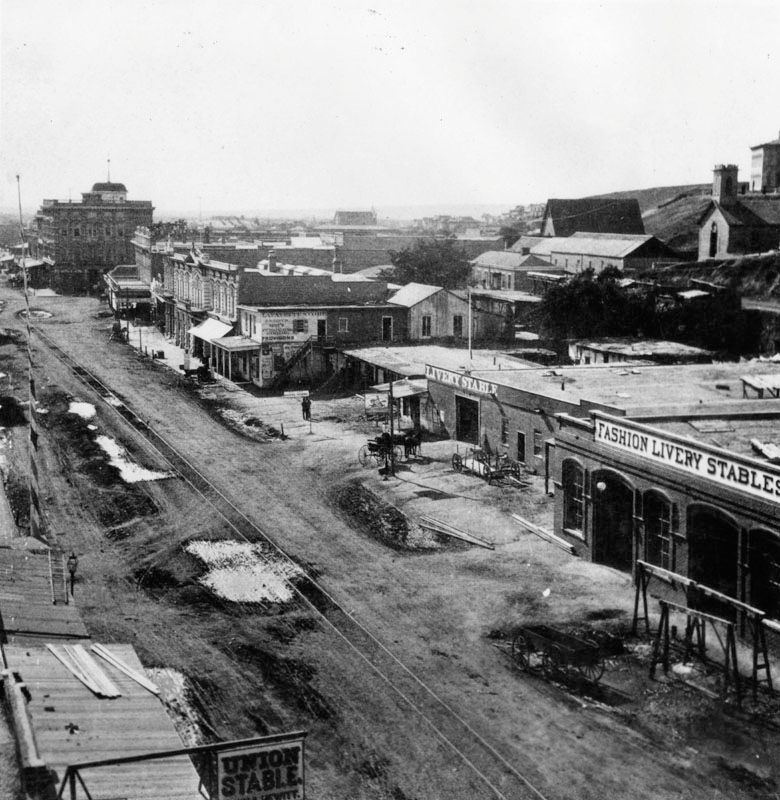
LAPL --
http://jpg2.lapl.org/pics08/00013998.jpg
Let's zoom in a bit. The Ferguson and Metzker Livery Stable sign is in the lower right corner. South of that, the small two-story building has LAFAYETTE STORE / P. N. ROTH (and other stuff) written on it; the larger two-story building next to it is the Lafayette Hotel. The Lafayette became the Cosmopolitan in April 1879 (
http://chroniclingamerica.loc.gov/lc...arRange&page=2) and later the St. Elmo. No shooting gallery sign yet:
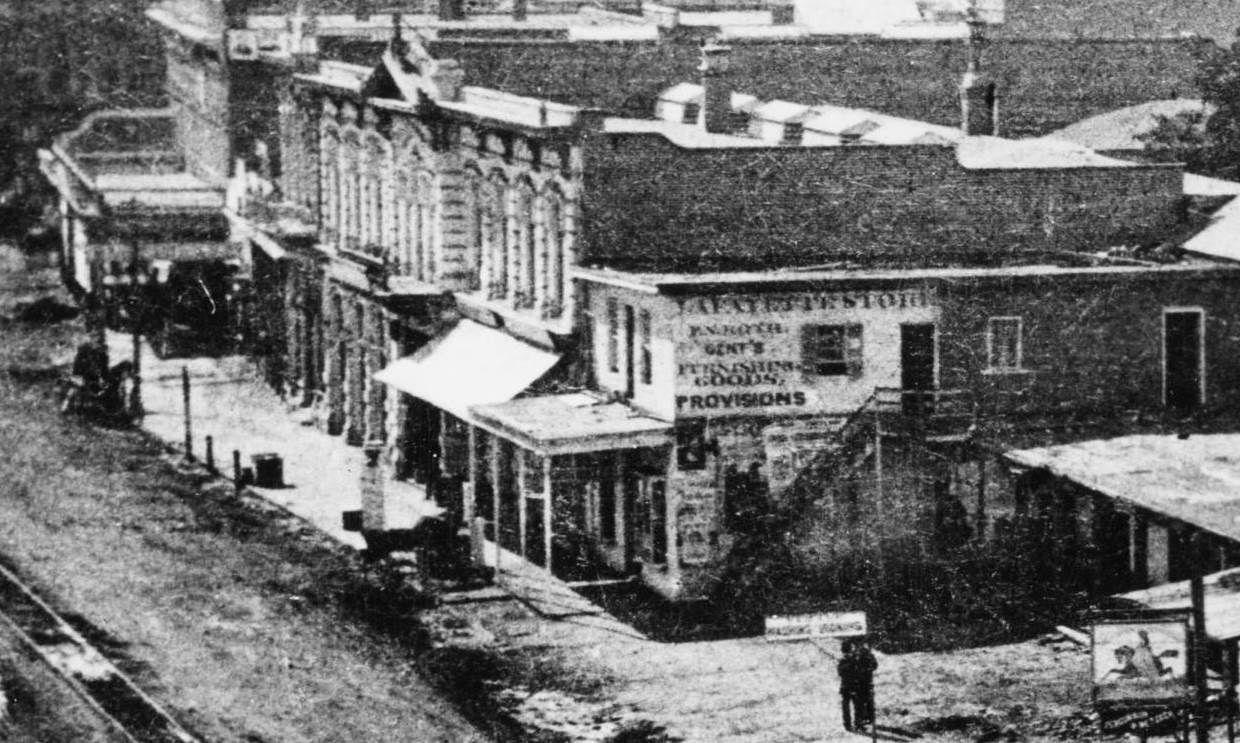
USC Digital Library --
http://digitallibrary.usc.edu/cdm/si...d/25547/rec/60
The photo above was probably not taken after the fall of 1875, since Mr. Roth went bankrupt that August, as reported in the August 22 1875 LA Herald:

Library of Congress --
http://chroniclingamerica.loc.gov/lc...arRange&page=3
In this undated, southwest-facing photo we have the shooting gallery sign as well as C. A. Bonesteel's name instead of P. N. Roth. Under the IMPORTANT sign there's a street address of 47 Main:
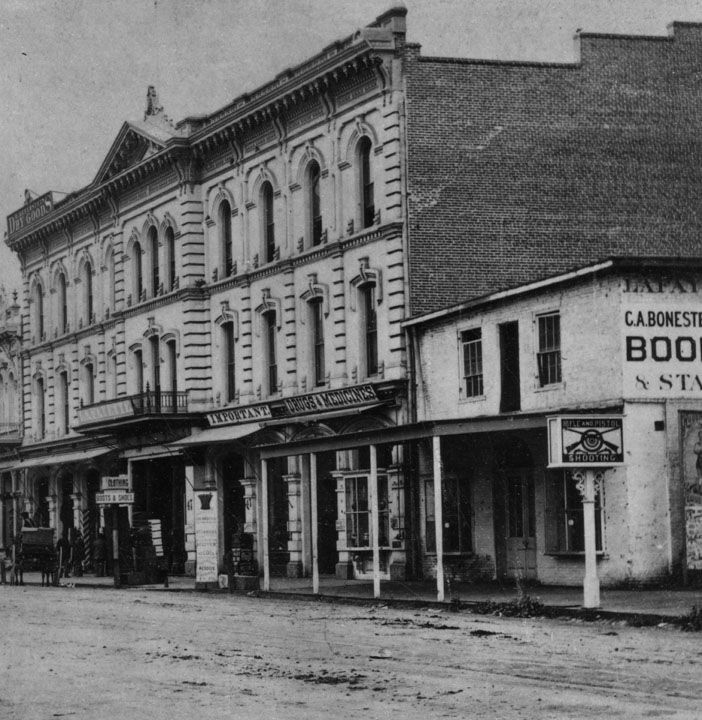
LAPL --
http://jpg1.lapl.org/spnb01/00007316.jpg
The CA State Library has another view of the above photo dated 1877: (
http://catalog.library.ca.gov/exlibr...XCRB2CGCAU.jpg)
Anyway, this LA Herald advertisement shows Mr. Bonesteel was in place by March 31, 1876:
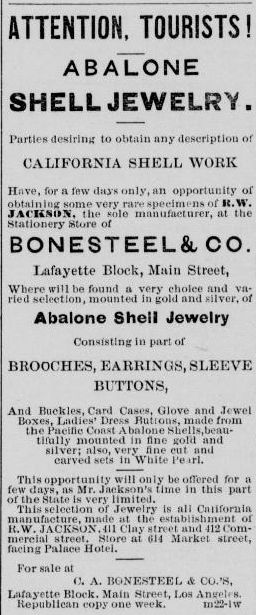
Library of Congress --
http://chroniclingamerica.loc.gov/lc...arRange&page=1
And there are a few other date clues from the photos. The IMPORTANT sign in the last photo above refers to a clothing store that was in operation by March 1876 (
http://chroniclingamerica.loc.gov/lc...rRange&page=10) and defunct by May 2, 1878:

Library of Congress --
http://chroniclingamerica.loc.gov/lc...arRange&page=1
Across the street on the east side of Main, the former Bella Union Hotel, which had been renamed the Clarendon, became the St. Charles in January 1875 (
http://chroniclingamerica.loc.gov/lc...arRange&page=1), but I couldn't find out when the three-story building immediately south of the St. Charles was built. In addition, there don't seem to be any newspaper pages from July 1876 to December 1877, and no city directories for 1876 or 1877, which are inconvenient gaps for this particular search.
We know for sure the shooting gallery was there in 1878, and likely into 1879. After that the trail runs cold, although by October 1880 Loiseau was running a saloon (
http://chroniclingamerica.loc.gov/lc...arRange&page=1). Given the readily available evidence, and assuming the shooting gallery and its sign existed simultaneously, the shooting gallery could also have been there in 1877, and possibly as early as 1876. I didn't see any references to it or Loiseau in 1875, but the OCR search at the Library of Congress isn't perfect.
Was the shooting gallery sign illuminated? It seems unlikely; were there many glass signs back then, illuminated or not? They couldn't have been cheap. Wouldn't you have to get up on a ladder to turn the gas on and off? The vents/smoke stacks at the top do suggest illumination -- or perhaps they were bird houses?

Maybe the sign was designed to be illuminated, but was not in this case? Was the shooting gallery even open at night? Perhaps it was just a weird old sign. Something else we'll never know for sure I guess.
Finally, exactly
where was the shooting gallery? Looking at the "Bonesteel" photo above showing 47 Main to compare, at first I thought the shooting gallery at 43 Main would have been in the Lafayette. But the street numbers ran the other way; i.e., larger to smaller going north (Did the street numbers radiate out from the Plaza back then? Did everyone know this but me?). How else do you explain these clips from the Jan 12, 1876 LA Herald?:



Library of Congress --
http://chroniclingamerica.loc.gov/lc...arRange&page=1
The Grand Central Hotel at 36-40 Main was north of the St. Charles. Both the St. Charles and the International boot store at 52 Main can be seen in
er's photo; look for the big boot in the street in front of the store (under the left edge of the shooting gallery sign). Mr. Herdman has his office in the Downey Block at 79-1/2 Main, which can be seen in the c. 1874 photo at the end of the block south of the Lafayette Hotel, which has the 47 Main address.
# # #
LATE EDIT: After further review, I believe the next paragraph is incorrect; the ones after that are OK, though.
So P. Loiseau's shooting gallery at 43 Main was in -- or at the former site of -- the one-story, perhaps adobe buildings immediately north of the Lafayette Store in the c. 1874 photo. New High Street, which can be seen one block west of Main Street in that photo, is higher than Main Street. So 43 Main would have been a good spot for a shooting gallery in that -- theoretically, depending on the layout -- you could shoot into a high dirt embankment.
OK -- no fooling this time -- P. Loiseau's shooting gallery at 43 Main was somewhere in -- or perhaps behind? -- the building with the Lafayette Store, the small two-story building (with an outside staircase leading to a 2nd floor door) immediately north of the Lafayette Hotel:
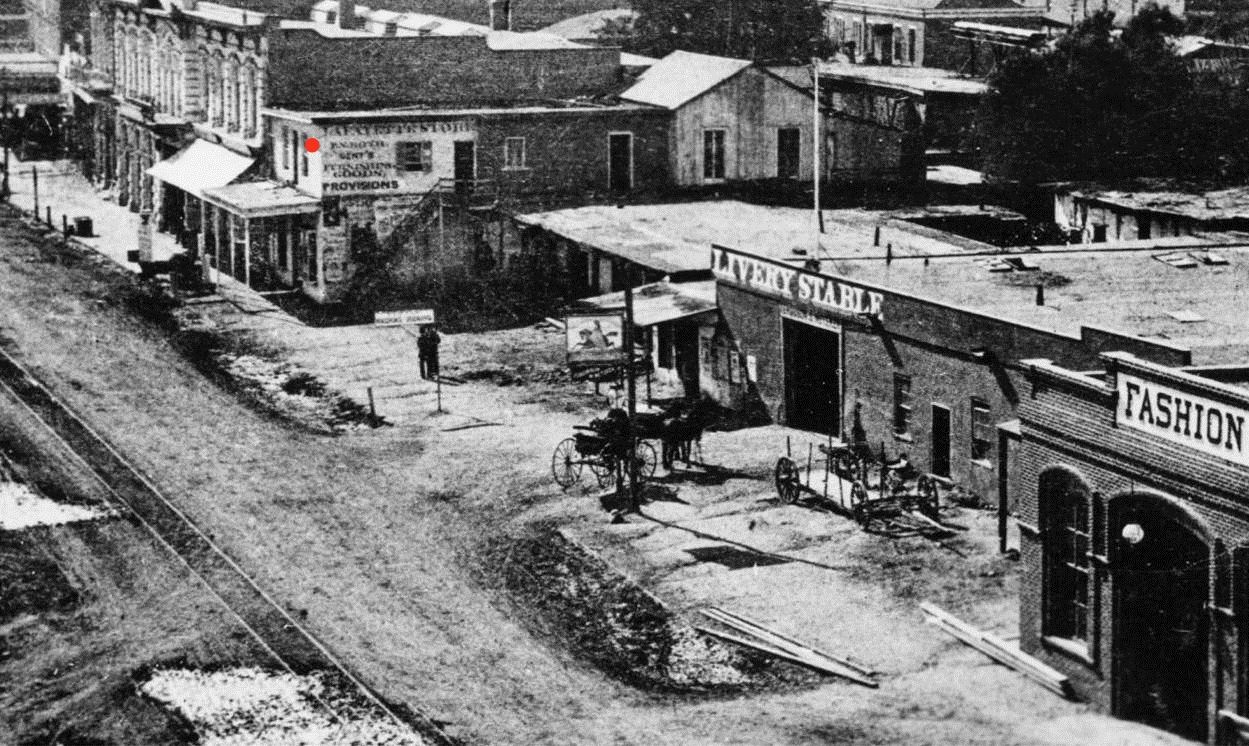
]
USC Digital Library --
http://digitallibrary.usc.edu/cdm/si...d/25547/rec/60

June 4, 1874 LA Herald @ Library of Congress

I should have figured it out from the photo above; since the IMPORTANT store was at 47 Main, with the DRUGS & MEDICINES store north of that at 45 Main, the smaller Lafayette Store building had to be 43 Main, where the 1879 LA City Directory says the shooting gallery was. The shape of those one-story buildings north of the Lafayette Store, which look vaguely like outdoor shooting ranges I've been to, combined with the high dirt embankment behind them, made me think the shooting gallery was there.
I also figured that the shooting gallery would be the only occupant of its building. But it would seem not; there was the Lafayette Store, and possibly other office space:
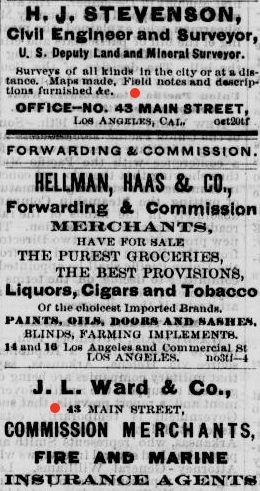
Nov 17, 1874 LA Herald @ Library of Congress



